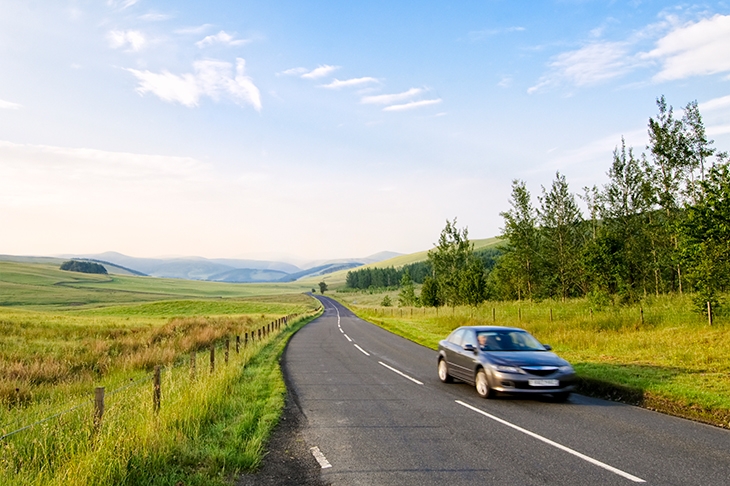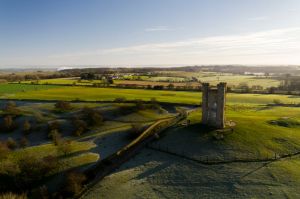In France I own a dented old Mercedes and in England a dented old Mitsubishi Carina. The Mercedes is parked in a cave and covered in sand dust and curling police notices in French; the Mitsubishi rots away in a lay-by in a country lane under a layer of wet leaves, mud and thatching straw. Owing to lockdown and poverty neither is fully functional nor has been started for months. Very occasionally I worry about them or experience a stab of shame at my pedestrianism. Last week I hired a budget car from the brand-new car-hire center at Bristol airport, the first time I’ve rented a car in 20 years.
The man behind the car-hire counter peered diplomatically at my torn and possibly historic paper driving license and the column of dense teleprinter type detailing my motoring convictions (two for drunk driving) and the driving bans (one for three years). Fortunately he grasped that all of these were issued when I was young and mental and that the man standing before his counter was now old and boring. Even though he hailed originally from one of the Baltic states, he could tell that straightaway — just by looking at me.
My offer of incontrovertible proof that at present I lived quietly in France, in the form of a letter addressed to me from a private clinic in Hyères, saying that I owed money, he waved politely aside as adding nothing of value to his first impression of all passion spent. He handed me the key to a Renault Captur without a qualm.
I say key, but it was an oblong of gray plastic which fitted into a slot. To start the engine you simultaneously depressed the clutch and pressed a kindergarten-sized button on the dashboard. I suppose that this system is already outdated and that today’s cars start with a voice command. But I have lived my car-owning life one technological stage up from the starting handle, and the intelligent key fob and start button seemed to me both amazing and ridiculous. And despite being the size and shape of a swanky SUV, this particular metallic navy Renault Captur, with its cartoon eyes for headlights, had the engine power of a moped. There was no ashtray.
I was quietly thrilled, however, to have temporary ownership of a newish motor car that was guaranteed to start every time. Both wing mirrors were unbroken and I could adjust the cabin temperature to within a degree centigrade at the turn of a lit knob. Rear cameras showed my reversing ability in color. The windscreen wipers didn’t squeak and knew it was raining before I did. All four tires had plenty of rubber left. There was no rubbish in the footwell and no rainbow-colored slicks when I parked over a puddle. Best of all, I was unimpeachably legal. I could relax. The car was mine for four days.
[special_offer]
Saving on the extra cost of a sat-nav system, I navigated with a phone app. On the last day of the hire period, my route was from West Sussex back to the car-hire center at Bristol airport. The app calculated a straight diagonal line across southern England along minor roads, beginning on the A272. I don’t know if you know the old A272? A relic of the golden age of motoring that ended with the first world war, 85 miles long and known as England’s longest lane? Although only 40 miles south of London, it runs continuously east to west through the small towns and villages and countryside of Sussex and Hampshire as a narrow but fast and well-kept two-lane highway. The English actor Dirk Bogarde’s cousin, an Anglophile Dutchman called Pieter Boogaart, fell so hopelessly in love with the A272 that he tried to explain that love in a level-headed way by writing a book about it called A272: An Ode to a Road. In it, along with the great writers who have lived on or near the A272, the old milestones and historic houses, he details the six rivers that flow under it, the nine railways lines, the 13 sets of traffic lights, the 31 roundabouts, 16 hotels, 21 churches and 32 pubs. ‘With hindsight,’ he says, ‘I can unequivocally say why I have come to love this road. It represents England. It epitomizes England.’
Can I qualify that by saying pre-war England?
After the wonderful A272, my phone app led me across the long straight empty roads of Salisbury Plain and over the Mendip Hills via country lanes so narrow I stopped several times to question it. Four hours, 150 miles. Surprisingly empty roads. Beautiful old England in her late summer pomp. Seen from a shiny car powered by a moped engine with climate control and reversing cameras. And all entirely legal. How I had missed driving. How I have missed England.
This article was originally published in The Spectator’s UK magazine. Subscribe to the US edition here.

























